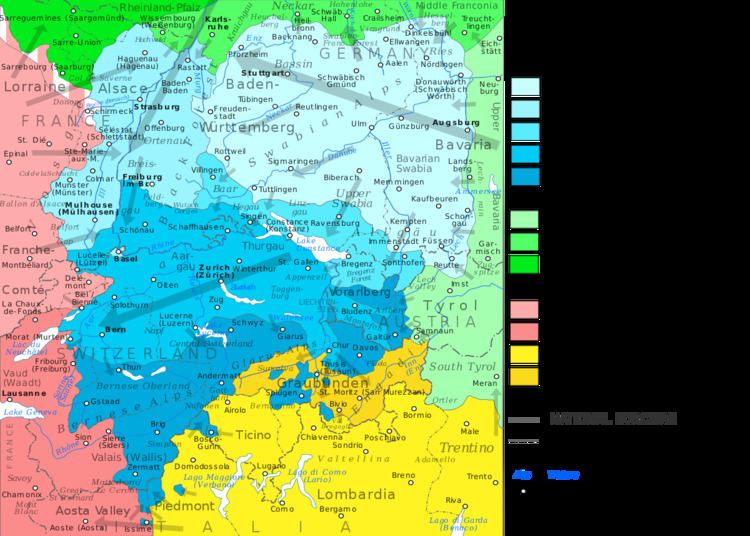Native to Germany ISO 639-3 swg | Native speakers 820,000 (2006) Glottolog swab1242 | |
 | ||
Language family Indo-European
Germanic
West Germanic
High German
Alemannic
Swabian Writing system Latin (German alphabet) | ||
Swabian ( Schwäbisch ) is one of the Alemannic dialects of High German. It is spoken in Swabia, which covers much of the southwestern German state of Baden-Württemberg, including its capital, Stuttgart. It is also spoken in the rural area known as the Swabian Alb, and in the southwest of Bavarian Swabia. Swabian is also nominally spoken by the Danube Swabian population of Hungary, the former Yugoslavia and Romania and by the Caucasus Germans.
Contents
Description
Swabian is difficult to understand for speakers of Standard German, not just because of its pronunciation but because it contains vocabulary that differs from Standard German. For example, "strawberry jam" in Standard German is Erdbeermarmelade while in Swabian it is Bräschdlingsgsälz.
In 2009, the word "Muggeseggele" (a Swabian idiom), meaning the scrotum of a housefly, was voted in a readers' survey by Stuttgarter Nachrichten, the largest newspaper in Stuttgart, as the most beautiful Swabian word, well ahead of any other term. The expression is used in an ironic way to describe a small unit of measure and is deemed appropriate to use in front of small children (compare Bubenspitzle). German broadcaster SWR's children's website, Kindernetz, explained the meaning of Muggeseggele in their Swabian dictionary in the Swabian-based TV series Ein Fall für B.A.R.Z.
Characteristics
In many regions, the Swabian dialect is spoken with a unique intonation that is also present when Swabian native speakers talk in Standard German. Similarly, a subtle but very prominent cue carrying over is the fact that the letter s is always pronounced voiceless - there is no voiced s in Swabian (or most southern dialects in general). While this should be very obvious to northern Germans, Swabian speakers are most often very unaware about this even while tending to speak perfect standard German in all other aspects.
The voiced plosives, the post-alveolar fricative, and the frequent use of diminutives based on "l" suffixes gives the dialect a very "soft" or "mild" feel, often felt to be in sharp contrast to the harder varieties of German spoken in the North.
Classification and variation
Swabian is categorized as an Alemannic dialect, which in turn is one of the two types of Upper German dialects (the other being Bavarian). The ISO 639-3 language code for Swabian is swg.
The Swabian dialect is composed of numerous sub-dialects, each of which has its own variations. These sub-dialects can be categorized by the difference in the formation of the past participle of 'sein' (to be) into gwäa and gsei. The Gsei group is nearer to other Alemannic dialects, such as Swiss German. It can be divided into South-East Swabian, West Swabian and Central Swabian.
Recognition in mass media
The Baden-Württemberg Chamber of Commerce launched an advertising campaign with the slogan "Wir können alles. Außer Hochdeutsch." which means "We can [do] everything. Except [speak] Standard German" to boost Swabian pride for their dialect and industrial achievements. However, it failed to impress Northern Germans and neighboring Baden. Dominik Kuhn (Dodokay) became famous in Germany with schwäbisch fandub videos, dubbing among others Barack Obama with German dialect vocals and revised text.
